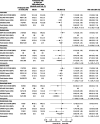Effect of SGLT2 Inhibitors on Stroke and Atrial Fibrillation in Diabetic Kidney Disease: Results From the CREDENCE Trial and Meta-Analysis
- PMID: 33874750
- PMCID: PMC8078131
- DOI: 10.1161/STROKEAHA.120.031623
Effect of SGLT2 Inhibitors on Stroke and Atrial Fibrillation in Diabetic Kidney Disease: Results From the CREDENCE Trial and Meta-Analysis
Abstract
Background and purpose: Chronic kidney disease with reduced estimated glomerular filtration rate or elevated albuminuria increases risk for ischemic and hemorrhagic stroke. This study assessed the effects of sodium glucose cotransporter 2 inhibitors (SGLT2i) on stroke and atrial fibrillation/flutter (AF/AFL) from CREDENCE (Canagliflozin and Renal Events in Diabetes With Established Nephropathy Clinical Evaluation) and a meta-analysis of large cardiovascular outcome trials (CVOTs) of SGLT2i in type 2 diabetes mellitus.
Methods: CREDENCE randomized 4401 participants with type 2 diabetes mellitus and chronic kidney disease to canagliflozin or placebo. Post hoc, we estimated effects on fatal or nonfatal stroke, stroke subtypes, and intermediate markers of stroke risk including AF/AFL. Stroke and AF/AFL data from 3 other completed large CVOTs and CREDENCE were pooled using random-effects meta-analysis.
Results: In CREDENCE, 142 participants experienced a stroke during follow-up (10.9/1000 patient-years with canagliflozin, 14.2/1000 patient-years with placebo; hazard ratio [HR], 0.77 [95% CI, 0.55-1.08]). Effects by stroke subtypes were: ischemic (HR, 0.88 [95% CI, 0.61-1.28]; n=111), hemorrhagic (HR, 0.50 [95% CI, 0.19-1.32]; n=18), and undetermined (HR, 0.54 [95% CI, 0.20-1.46]; n=17). There was no clear effect on AF/AFL (HR, 0.76 [95% CI, 0.53-1.10]; n=115). The overall effects in the 4 CVOTs combined were: total stroke (HRpooled, 0.96 [95% CI, 0.82-1.12]), ischemic stroke (HRpooled, 1.01 [95% CI, 0.89-1.14]), hemorrhagic stroke (HRpooled, 0.50 [95% CI, 0.30-0.83]), undetermined stroke (HRpooled, 0.86 [95% CI, 0.49-1.51]), and AF/AFL (HRpooled, 0.81 [95% CI, 0.71-0.93]). There was evidence that SGLT2i effects on total stroke varied by baseline estimated glomerular filtration rate (P=0.01), with protection in the lowest estimated glomerular filtration rate (<45 mL/min/1.73 m2]) subgroup (HRpooled, 0.50 [95% CI, 0.31-0.79]).
Conclusions: Although we found no clear effect of SGLT2i on total stroke in CREDENCE or across trials combined, there was some evidence of benefit in preventing hemorrhagic stroke and AF/AFL, as well as total stroke for those with lowest estimated glomerular filtration rate. Future research should focus on confirming these data and exploring potential mechanisms. Registration: URL: https://www.clinicaltrials.gov; Unique identifier: NCT02065791.
Keywords: atrial fibrillation; canagliflozin; glomerular filtration rate; hemorrhagic stroke; ischemic stroke.
Figures




Comment in
-
Treating Diabetes to Prevent Stroke.Stroke. 2021 May;52(5):1557-1560. doi: 10.1161/STROKEAHA.120.032725. Epub 2021 Apr 20. Stroke. 2021. PMID: 33874746 No abstract available.
References
-
- Toyoda K, Ninomiya T. Stroke and cerebrovascular diseases in patients with chronic kidney disease. Lancet Neurol. 2014;13:823–833. doi: 10.1016/S1474-4422(14)70026-2 - PubMed
-
- Mahmoodi BK, Yatsuya H, Matsushita K, Sang Y, Gottesman RF, Astor BC, Woodward M, Longstreth WT, Jr, Psaty BM, Shlipak MG, et al. . Association of kidney disease measures with ischemic versus hemorrhagic strokes: pooled analyses of 4 prospective community-based cohorts. Stroke. 2014;45:1925–1931. doi: 10.1161/STROKEAHA.114.004900 - PMC - PubMed
-
- Ghoshal S, Freedman BI. Mechanisms of stroke in patients with chronic kidney disease. Am J Nephrol. 2019;50:229–239. doi: 10.1159/000502446 - PubMed
-
- Bilha SC, Burlacu A, Siriopol D, Voroneanu L, Covic A. Primary prevention of stroke in chronic kidney disease patients: a scientific update. Cerebrovasc Dis. 2018;45:33–41. doi: 10.1159/000486016 - PubMed
Publication types
MeSH terms
Substances
Associated data
LinkOut - more resources
Full Text Sources
Other Literature Sources
Medical

